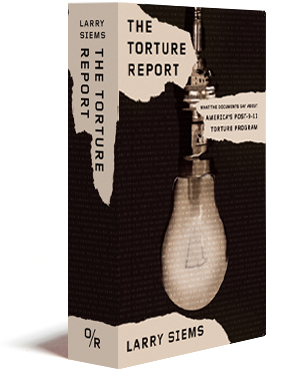Black Sites, Lies, and Videotape
Gina Haspel, President’s nominee to lead the CIA, will testify in front of Congress today about her supervision of a black site in Thailand where detainees are known to have been tortured. Hers is a role the CIA—which at the time had no organizational background or experience running detention facilities—has deliberately obscured. Below, from Larry Siems’ 2011 book The Torture Report, is an account of the torture of a number of detainees in Thailand, as well as a look into the site’s administration around the time of Haspel’s tenure.

On November 20, 2002, a suspected Afghan military in his early thirties named Gul Rahman was doused with water, shackled naked to the floor, and left overnight in a frigid cell in a CIA black site known as “The Salt Pit” on the outskirts of Kabul, Afghanistan. He died of hypothermia. The supervisor of the facility, an agent with no experience as an interrogator or a jailer, ordered him buried in an unmarked grave.
As this was happening, the CIA was dispatching one of its lawyers to the black site in Thailand to review the videotapes of the Abu Zubaydah interrogation. For weeks the agency had been discussing destroying the tapes; a cable sent from the secret prison to headquarters in August, the month Zubaydah was waterboarded eighty-three times, discussed “the security risks of videotape retention” and suggested “new procedures for videotape retention and disposal.” A September 6, 2002 email between CIA attorneys has as its subject “Destruction proposal on disposition of videotapes at fi eld,” and an email two months later “from a CIA officer to CIA officers and attorneys” dated November 6 follows up with the “proper procedures for destruction of the interrogation videotapes.”
But Langley had decided it wanted a “random independent review” of the tapes first, and so in late November, an attorney from the CIA General Counsel’s office was sent to verify that Abu Zubaydah’s torment had followed the approved script. With his assurances that it had, the discussion resumed: on November 27, a cable was sent from the black site “requesting approval for destruction of the interrogation tapes,” and on December 3, 2002, headquarters responded with a cable with the subject line “Closing of facility and destruction of classified information” and an email “outlining the destruction plan for the videotapes.”
In the midst of this exchange, back in Afghanistan, CIA agents delivered a young mullah named Habibulah into the hands of army interrogators at Bagram Collection Point, a converted hangar at the former Soviet airbase about fifty kilometers north of Kabul. Within a week, an Armed Services Medical Examiner reported, “the remains” were “presented for autopsy clothed in a disposable diaper. No additional clothing or personal effects accompan[ied] the body.”
Habibulah had been “found unresponsive, restrained in his cell”—handcuffed to the wire mesh ceiling of the plywood-walled isolation cell, that is—at 12:15 a.m. on December 4, 2002. The military first claimed he had died of natural causes. The Medical Examiner, however, concluded the cause of death was “pulmonary embolism due to blunt force injuries”; the Manner of Death, “homicide.”
The day Habibulah was killed, the CIA switched off the video cameras and closed down its black site in Thailand. In addition to the torture of Abu Zubaydah, they had for the previous two weeks been recording the interrogation of a second “high value detainee,” Abd al-Rahim al-Nashiri, whose arrest the administration trumpeted on November 21, 2002. Th e alleged chief of Al Qaeda operations in the Persian Gulf and the suspected organizer of the 2000 bombing of the USS Cole, al-Nashiri was captured in Dubai in October and held for a time at the Salt Pit in Afghanistan before being flown to Thailand on November 15—where, as the CIA’s Inspector General observes blandly, “The interrogation proceeded after [redacted] the necessary authorization.”
“Psychologist/interrogators began Al-Nashiri’s interrogations using EITs immediately upon his arrival,” the Inspector General reported. A largely redacted documented headed “Summary,” “CTC’s interrogation efforts” [redacted] “with the interrogation of Al-Nashiri” dated November 20, 2002 records that “Al-Nashiri has undergone [redacted] interrogation with the HVT interrogators using [redacted]” and “Al-Nashiri is becoming more compliant and is providing actionable intelligence.” Even so, Mitchell’s team kept climbing the force continuum. The Inspector General found that although al-Nashiri “provided lead information on other terrorists during his first day of interrogation,” the use of EITs continued for eleven more days, and on the twelfth day, “psychologist/interrogators administered two applications of the waterboard to Al-Nashiri during two separate interrogation sessions.”
They didn’t stop there. Th e cameras were switched off on December 4th; that day, al-Nashiri and Zubaydah were bundled onto a CIA-leased jet and flown to Dubai and on to a new secret CIA detention facility located near the airport in Szymany, Poland. The plane, a leased twenty two-seat Gulfstream jet carrying the two detainees and the six-person CIA rendition team, landed in Poland on December 5th; al-Nashiri’s “enhanced interrogation” resumed immediately and continued for two more weeks, at which time his interrogators “assessed him to be ‘compliant.’”

The Torture Report
What the Documents Say About America’s Post-9/11 Torture Program
“A chilling account of the use and justification of torture by the Bush Administration, made the more powerful by its dispassionate, forensic language.” —Salman Rushdie More |
Further Reading
- Gina Haspel, the CIA, and THE TORTURE REPORT (5/9/2018)
- THE TORTURE REPORT author LARRY SIEMS pens op-ed with Jameel Jaffer for the LA Times (8/15/2014)
- Francine Prose recommends THE TORTURE REPORT in the New York Times Sunday Book Review (1/7/2013)
- The Nation reviews THE TORTURE REPORT (7/26/2012)
- Scott Cohen calls THE TORTURE REPORT “epic” in The Atlantic (2/6/2012)
- ACLU Studios’ podcast features THE TORTURE REPORT with author Larry Siems (1/9/2012)


